Indoor plants are a good option for keeping home beautiful and fresh. But if you have cats or dogs as a pet in your house should study about the plant you are bringing and their compatibility with your pets. Here is the list of some indoor plants toxic to pets with their degree of toxicity, symptoms, and treatments.
19 Indoor plants toxic to pets
1. Philodendron scandens

This plant belongs to the Araceae family to have heart-shaped leaves. This plant causes lethal poisoning in cats. The plant mainly the trunk and leaves contain calcium oxalate and protein degrading enzymes (2).
Toxicity to: Cat
Symptoms: Affects the digestive system, kidney, and lungs. Rashes and toxic erythema on skin.
Treatment: Administration of antihistamine, consult a vet immediately
2. Lily (Lilium Species)
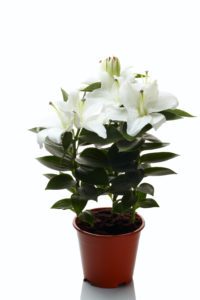
Lily belongs to the Liliaceae family. This plant is well known for its showy attractive flowers of different colors. The plant’s leaves and bulbs are toxic to cats as they contain alkaloids thus causes kidney failure or pancreatic toxicity (3).
Main lily toxic to cats are
- Easter Lily
- Tiger Lily
- Rubrum Lily
- Stargazer Lily
- Day Lily
- Asiatic Lily
- Madonna Lily
- Royal Lily
- Japanese Lily
Toxicity to: Cat
Symptoms: Vomiting, depression, diluted urine (polyurea), polydipsia (drinking a large amount of water), Loss of glucose (glucosuria) and Protein (proteinuria) from urine.
Treatment: Decontamination with emetic drugs (within 2 hours from ingestion) or administering activated charcoal and aggressive fluid therapy as soon as possible, continuing it for at least 48 h (2). Consultation of a Vet.
3. Daffodils

These plants can be grown mainly as outdoor but some time also grew as an indoor plant. Another name of this plant is Narcissus belong to the Amaryllidaceae family. The plant is known for its beautiful flowers. Bulbs, leaves, and flowers contain compound alkaloids which are toxic to cats.
Toxicity to: Cat and Dog
Symptoms: Diarrhoea, vomiting, abdominal pain, anorexia, lethargy, depression. High amount even causes death.
Treatment: specific treatment is not available. Consult a vet for symptomatic treatment (2).
4. Peace lily

The peace lily is a beautiful evergreen perennial herbaceous plant of genus Spathiphyllum. The compound which is toxic to cats are mainly alkaloids present in the bulbs and leaves.
Toxicity to: Cat
Symptoms: Causes renal failure and other kidney related issues, vomiting and loss of excess fluids, lethargy.
Treatment: Decontamination with emetic drugs and consult a vet immediately.
5. Pothos or Devil’s eye (Epipremnum species)
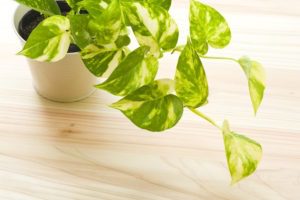
These plants are commonly used in almost every hose as an indoor plant. Being easy to handle and nice greeny appearance makes this plant a good choice as an indoor plant. But people who have cats should not keep this plant in their houses. This plants contain insoluble calcium oxalate in their leaves and is partially poisonous to cats.
Toxicity to: Cat
Symptoms: Swelling of lips, drooling and vomiting
Treatment: Milk can helps in overcoming the symptoms. But if conditions get worsens then seeking a vet is a must.
6. Dracaena (Dracaena marginata) variegata
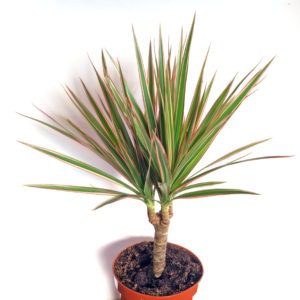
Dracaena (Dracaena marginata) commonly known as Tricolour or Rainbow plant is a popular house plant. The leaves are stripped cream white between green and rose red margins therefore known as Tricolour.
The leaves of this plant contain saponin. Although have minor poisoning risk in case situation worsen consult a vet.
Toxicity to: Cat
Symptoms: Chewing of the leaves may cause vomiting, drooling, lethargy, diarrhea, loss of appetite and dilated pupils.
Treatment: Condition if gets worsens consult a vet.
7. Kalanchoe
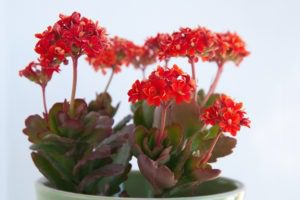
Kalanchoe is a succulent perennial plant. The plan looks very attractive with thick succulent leaves with colorful flowers. The plant is not only a good indoor plant but also have medicinal value because of various glycosides, alkaloids, and steroids present in them(4). But if you have a cat it is better to keep this plant away from them. As the glycosides present in the plant when ingested causes gastrointestinal discomfort.
Toxicity to: Cat
Symptoms: Drooling, vomiting, nausea, abdominal pain, irregular heartbeat and dilated pupils (5).
Treatment: Decontamination, heart and blood pressure monitoring.
8. Rubber plant (Ficus elastica)
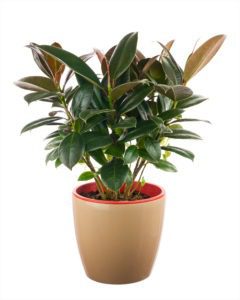
The rubber plant is a beautiful plant with attractive leaves. This plants not only add beauty to the indoor but also helps in purifying the air quality. The main toxic compound is the latex present in the leaves and stems. Although eating the leaves causes mild toxicity for the pets but still, precaution is needed.
Toxicity to: Cat and Dog
Symptoms: Digestive disorder, diarrhea, skin lesions, renal disorders (6).
Treatment: Should consult a vet.
9. Poinsettia (Euphorbia pulcherrima)

Poinsettia is an indoor decorating plant originate in Mexico and scientifically known as Euphorbia pulcherrima. Another name is holiday plant as it blooms during the month of October. The beautiful red leaves make it a good choice for an indoor plant. But if there are pets in the house then consider before getting this plant. Latex of this plant have cyclic terpenes and therefore is toxic for cats (2).
Toxicity to: cat
Symptoms: Conjunctivitis, photophobia, digestive disorders.
Treatment: Wash the affected part with lukewarm water. Consult a Vet in case of ingestion.
10. Asparagus fern (Asparagus sprengeri)

Ferns are generally not toxic to cats but there are certain species which when ingested causes mild toxicity. The parts of asparagus fern contain compound sapogenin especially berries. This is toxic for cats as causes abdominal discomfort.
Toxicity to: Cat and Dog
Symptoms: abdominal discomfort, pain, vomiting, diarrhea.
Treatment: Severe condition required Vet consultation.
11. Arrowhead vine or Nephthytis (Syngonium podophyllum)

This plant is an indoor air purifying plant with beautiful arrow-shaped bicolor leaves. This plant is generally mild toxic to cats if ingested. The leaves of this plant contain oxalate crystals which cause abdominal irritation or discomfort, drooling, etc.
Toxicity to: Cat
Symptoms: drolling, oral irritation, discomfort in breathing, and abdominal irritation.
Treatment: Consult a Vet if the condition gets worsens.
12. Sago palm
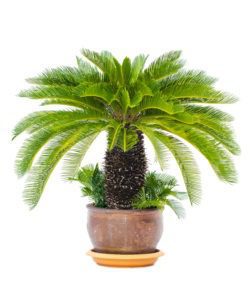
Sago palm or cycad is a beautiful ornamental plant. The plant is beautiful but is also very toxic especially to dogs. The main toxic compound present in Sago is azoxy glycosides. Consumption of this compound may result in gastrointestinal disorder, hepatotoxicity, and carcinogenicity (3).
Toxicity to: Dog
Symptoms: Diarrhea, liver failure, vomiting, and death in the worst case.
Treatment: Immediately consult a Vet.
13. Azalea
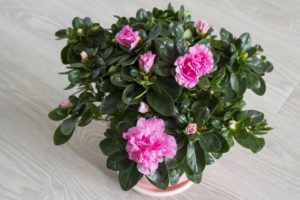
The scientific name of Azalea is Rhododendron simsii. It belongs to the family Ericaceae. It is a beautiful ornamental plant with colorful flowers. But persons who have enthusiastic dogs in their houses should consider its side effects before getting them. The toxic parts are leaves, containing a grayanotoxin.
Toxicity to: Dog
Symptoms: Leaves cause anorexia, depression, hypersalivation, emesis, colic, tenesmus, tachypnea followed by bradypnea (4). Other symptoms of poisoning include kidney and liver failure.
Treatment: No specific therapy exists. Consult a Vet.
14. Dumb cane (Diefenbachia spp.)

It belongs to the family Araceae. Although the plant is beautiful its leaves and trunks are toxic to dogs. Leaves contain calcium oxalate crystals. Ingestion causes mechanical injuries to mast cells, favoring the release of histamine.
Toxicity to: Dog
Symptoms: Irritation in mucus, salivation, paralysis of the tongue, and dysphagia. The digestive disorder, skin, kidney, and respiratory apparatus, with the death of the animal following the ingestion of large amounts of the plant [4, 5].
Treatment: Administration of antihistamine and washing the mouth with sodium bicarbonate solution or water. Removing the residues of the plant from the stomach of the animal by administering emetic drugs represents a good practice if the ingestion has happened within the last two hours (2).
15. Elephant’s ear (Colocasia esculenta)
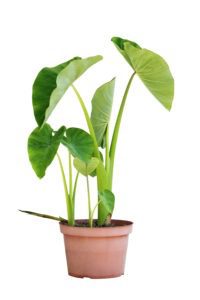
These plants are known for their large elephant-shaped leaves which is the main attractive feature. Ingestion of the leaves by dogs and other animals causes discomfort because of the toxic chemicals present in the leaves.
Toxicity to: Dog
Symptoms: Oral pain, vomiting, difficulty in breathing, abdominal discomfort.
Treatment: Consult a vet for proper therapy.
16. Ivy
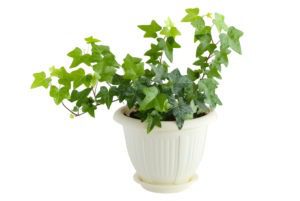
There are around 15-12 species that come under Ivy. It is commonly known as Hedera of Araliaceae family. All the plants come under are a climber in nature. The leaves of ivy contain triterpenoid saponin which is toxic to animals.
Toxicity to: Dog
Symptoms: Dogs show dermatitis with diarrhea, vomiting, and abdominal pain.
Treatment: Consult a Vet.
17. Aloe vera
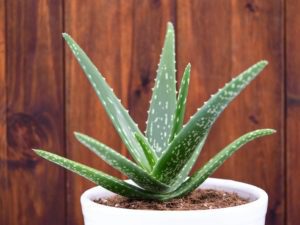
Aloe vera belongs to the family Liliaceae is a medicinal plant. This plant is generally used as an outdoor plant or a balcony plant. The gel of this plant is used in the treatment of hair, sunburns, and eczema. Although aloe vera is rarely poisonous to pets but still because of its gel and other compounds present in the cat and dogs suffer milder problems.
Toxicity to: Cats and Dogs
Symptoms: Vomiting and diarrhea
Treatment: Consult a Vet in case the condition gets worsens.
18. Chrysanthemum
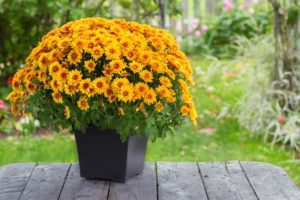
Chrysanthemum is scientifically known as Chrysanthemum morifolium (1) Ramat is an ornamental plant known for its colorful attractive flowers. The plant is widely cultivated for its flowers. It can also be used both as an indoor and outdoor plant. The plant is toxic to dogs and cats.
Toxicity to: Cats and dogs
Symptoms: Ingestion of this plant causes vomiting, diarrhea, and excessive salivation
Treatment: Mild symptoms like skin irritation can go by itself. But in case of severity consult a Vet.
19. Snake plant
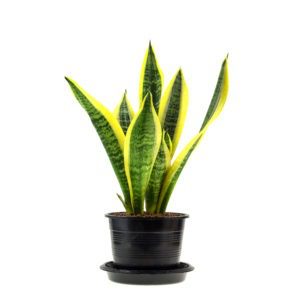
Commonly known as Mother-in-law’s-tongue and scientific name is Sansevieria trifasciata. This is a good indoor plant with air purifying property. Toxic to both cat and dog because of the compound like saponin and glycosides.
Toxicity to: Cats and dogs
Symptoms: Diarrhea, vomiting, excessive saliva and lethargy
Treatment: although the symptoms are mild in case of severity consult a Vet.

[…] Click here to know more >> […]